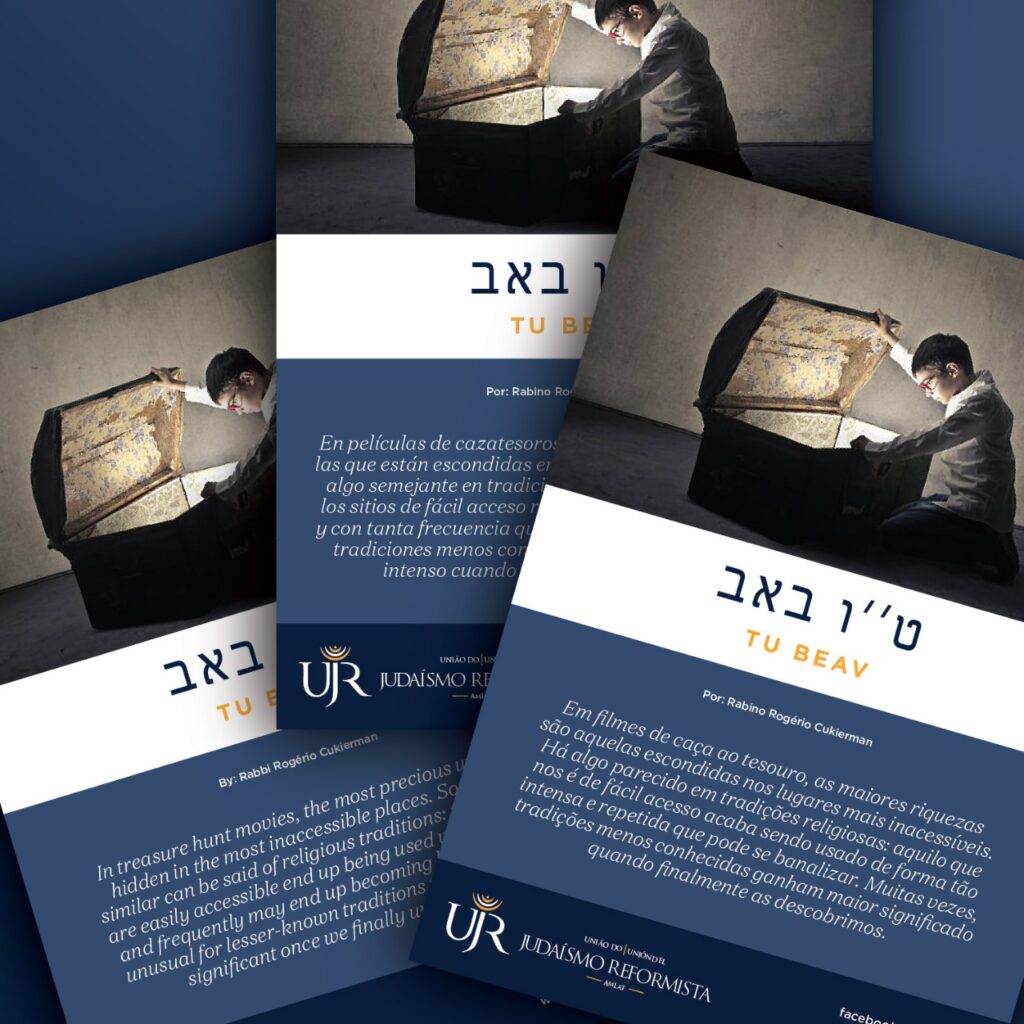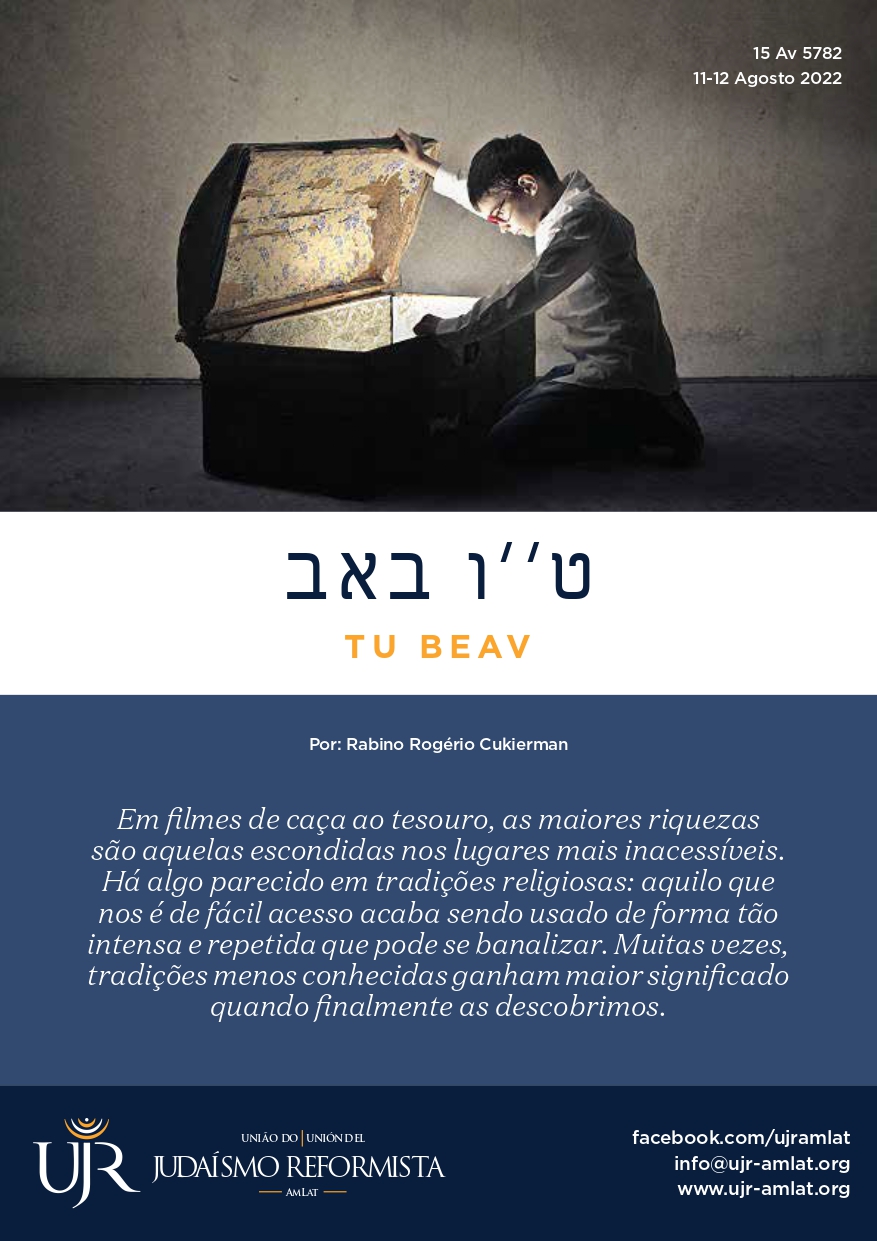ט׳׳ו באב
Tu beAv
15 Av 5782
August 11-12, 2022
In treasure hunt movies, the most precious wealth is hidden in the most inaccessible places. Something similar can be said of religious traditions: those which are easily accessible end up being used very intensely and frequently may end up becoming banal. It is not unusual for lesser-known traditions to become more significant once we finally unveil them.
Tu beAv is a so-called “minor” Jewish holiday and, as such, sometimes receives little attention. While researching for this article, I went back to some of my favorite books on the Jewish calendar, and practically none of them mentioned the date. The search for its several layers of meaning, however, promises special rewards to those who make it to the end of this journey.
Tu beAv, the fifteenth day of the Jewish month of Av, takes place amid a celebratory twist of sorts. It follows a period of three weeks of intense mourning, which culminate in Tisha beAv, the focal point of all Jewish historical tragedies. That is why a Mishnah establishes that “from when the month of Av begins, one decreases acts of rejoicing.” However, another Mishnah states that “there were no days as joyous for the Jewish people as the fifteenth of Av and as Yom Kippur.” This sudden change of heart—from the saddest day of the year to one of the happies days of the year—over only five days makes this transition even more intense.
What made Tu beAv such a happy day? Archeologists say that this was originally a pagan festival that celebrated fertility and fermentation. But the first clue as to its Jewish origins comes from the Mishnah itself, which describes the date as a benchmark of happiness in the Jewish calendar. The Mishnah describes how, on this date, young girls go out in the streets of Jerusalem wearing borrowed white clothes, so as not to embarrass those who didn’t have any. They went out and danced in the vineyards, inviting men to choose their partners without paying attention to their looks. The image of dancing in white garments in the fields evokes a romantic perspective and helps to explain why Tu beAv became known as a Jewish celebration of love.
Even so, this portion of the Mishnah does not explain why this celebration happens on the 15th of Av, so the sages of the Talmud were tasked with digging deeper into the issue. The sages offer many explanations, some of them connected with the suspension of the prohibition of marriage between different tribes; other explanations relate the date with events in Jewish history, such as the cessation of deaths among the generation that had left Egypt, the end of the prohibition of going to Jerusalem in the days of king Hoshea, or when the victims of the Beitar massacre could finally be buried. Another explanation is that, as of the 15th day of Av, the sun becomes less bright in the Land of Israel, making it harder for the wood that burned in the Altar at the Temple to dry; that is why they stopped chopping down trees on this date.
As with every good mystery, an apparently insignificant detail leads us to a fundamental discovery that ultimately allow us to piece together the entire story: the cutting of wood for the Altar. One Mishnah lists a number of days set aside for different distinguished groups to bring wood. The 15th day of Av was reserved to those who had failed to appear on the correct date and to lesser social strata. According to the Romano-Jewish historian Flavius Josephus, who lived in the 1st century CE, it once came to pass that there were so many attendants to the wood-burning ceremony on the 15th of Av that they overpowered the Roman soldiers and drove them out of the upper city by force. The crown then carried the fire to the place where the archives were reposited, and burned the contracts belonging to their creditors, and thereby dissolved their debt obligations. This aspect of this holiday, it is said, received little attention in rabbinical literature out of fear that the Roman authorities would be offended and would prohibit its celebration.
Thus we can see how Tu beAv finds its place amid the central Jewish dates: just like Hanukkah, its self-determination component was sublimated out of fear for the authorities’ reaction; as with Pesach, Shavuot, and Sukkot, it has an agrarian component relating to the seasons and their impact on nature; just like Rosh Hashanah and Yom Kippur, it invites us to dig beneath the surface of appearances and to the most essential truths in each person. As with many other dates in our religious calendar, it may have originated out of a celebration belonging to another culture, having since been fully appropriated and become entirely Jewish.
But notice how Tu beAv also has a unique character: it was on the 15th day of Av that young women in Jerusalem wore different clothes, so their suitors couldn’t tell the rich girls from the poor ones; it was on the 15th day of Av that the lesser social strata brought their wood offerings to the Temple; and it was on the 15th day of Av that the crowd, through a popular revolt, brought an end to the financial oppression that plagued the peasantry of the time. These three situations emphasize equality and protection to the most vulnerable social groups. Given that the holiday became associated with romantic love, it is fundamental that we integrate these two concepts, identifying which groups’ romantic lives are at the greatest peril, and developing concrete action to protect them and guarantee that they may love whoever it is that they love.
In Judaism, love is action—Tu beAv may just be the date to put that in practice.
—





